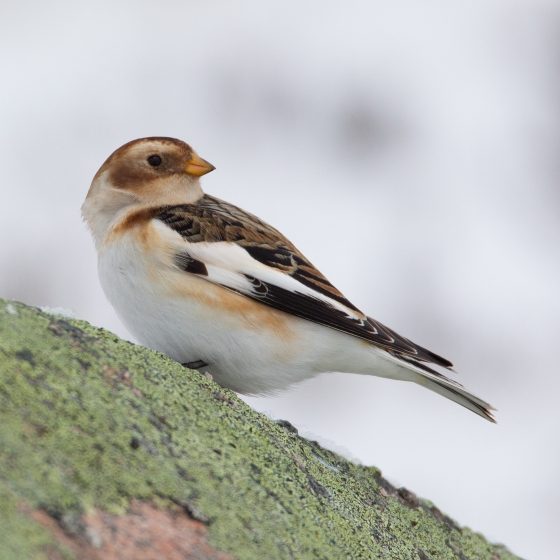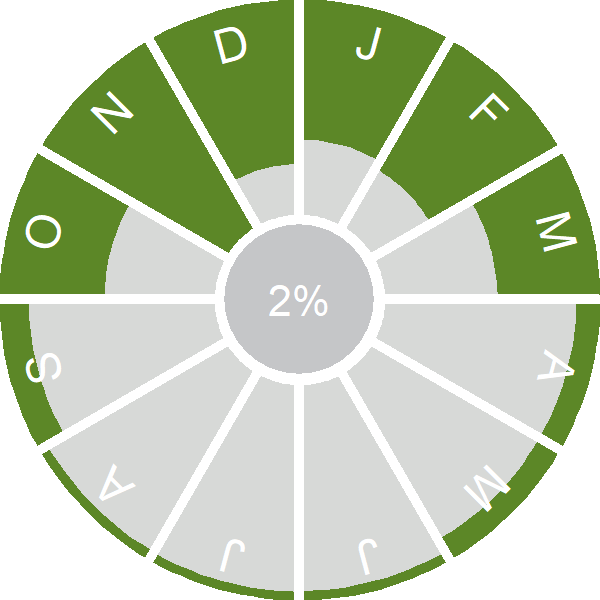Snow Bunting

Introduction
Snow Buntings are predominantly a winter visitor to Britain & Ireland although a tiny breeding population remains amongst snow fields on the highest Scottish mountains.
Winter visitors from northern breeding grounds in Iceland and Fennoscandia are widely distributed across the uplands of Scotland and England, and to a lesser extent Wales and the island of Ireland. However, most birdwatchers will encounter flocks of this confiding little bird on North Sea coasts from the Tees to Norfolk. The population in winter has increased by a third in 40 years.
In the breeding season, Snow Buntings adopt a very smart white summer dress, with black wings and tail making a superb contrast as they flutter across high mountain snowfields with their sweet bubbling call. You have to be lucky or determined to see them though, as the most recent survey identified only around 80 breeding territories in this harsh landscape.

Key Stats
Identification
ID Videos
This section features BTO training videos headlining this species, or featuring it as a potential confusion species.
Winter buntings
Songs and Calls
Song:
Call:
Status and Trends
Conservation Status
Population Change
The Snow Bunting is restricted as a UK breeding species to mountainous areas of Scotland where it breeds in small numbers. It is an Rare Breeding Birds Panel species but is under-reported due to the difficulties in finding and monitoring birds in such challenging habitat (Eaton et al. 2021). It is believed that the population may have increased during the 1970s and 1980s although the possibility that the recorded increases may have resulted from higher levels of observer coverage cannot be ruled out (Watson & Smith 1991).The population appears to have subsequently remained relatively stable and the population estimate from the last full survey in 2011 was 60 territories (Hayhow et al. 2018). The breeding range in 2008–11 was substantially larger than it was in 1968–72 but smaller than in 1988–91 (Balmer et al. 2013).
Distribution
A small relict population of Snow Buntings breeds on the high tops of mountains in the Cairngorms and northwest Highlands. During 2008–11
Occupied 10-km squares in UK
or view it on Bird Atlas Mapstore.
or view it on Bird Atlas Mapstore.
European Distribution Map
Distribution Change
The Snow Bunting range extent detected in 2008–11 was substantially larger than in the 1968–72 Breeding Atlas but smaller than in the 1988–91 Breeding Atlas. Occupancy figures are likely to be heavily influenced by the intensity of coverage on the high tops inhabited by this species. Nevertheless, other data confirm this trend. In winter there has been a 34% range expansion since the 1980s, with gains in the uplands and on the margins of the coastal range, in south and southwest England, Wales and Ireland.
Change in occupied 10-km squares in the UK
or view it on Bird Atlas Mapstore.
or view it on Bird Atlas Mapstore.
Seasonality
Snow Bunting is a localised breeder, autumn passage migrant and localised winter visitor.
Weekly pattern of occurrence
The graph shows when the species is present in the UK, with taller bars indicating a higher likelihood of encountering the species in appropriate regions and habitats.

Movement
Britain & Ireland movement
Foreign locations of birds ringed or recovered in Britain & Ireland
Dots show the foreign destinations of birds ringed in Britain & Ireland, and the origins of birds ringed overseas that were subsequently recaptured, resighted or found dead in Britain & Ireland. Dot colours indicate the time of year that the species was present at the location.
- Winter (Nov-Feb)
- Spring (Mar-Apr)
- Summer (May-Jul)
- Autumn (Aug-Oct)

European movements
EuroBirdPortal uses birdwatcher's records, such as those logged in BirdTrack to map the flows of birds as they arrive and depart Europe. See maps for this species here.
The Eurasian-African Migration Atlas shows movements of individual birds ringed or recovered in Europe. See maps for this species here.
Biology
Productivity and Nesting
Nesting timing
Egg measurements
Clutch Size
Survival and Longevity
Survival is shown as the proportion of birds surviving from one year to the next and is derived from bird ringing data. It can also be used to estimate how long birds typically live.
View number ringed each year in the Online Ringing Report.
lifespan
Survival of adults
Biometrics
Wing length and body weights are from live birds (source).
Wing length
Body weight
Ring Size
Classification, names and codes
Classification and Codes
- Order: Passeriformes
- Family: Calcariidae
- Scientific name: Plectrophenax nivalis
- Authority: Linnaeus, 1758
- BTO 2-letter code: SB
- BTO 5-letter code: SNOBU
- Euring code number: 18500
Alternate species names
- Catalan: sit blanc
- Czech: snehule severní
- Danish: Snespurv
- Dutch: Sneeuwgors
- Estonian: hangelind
- Finnish: pulmunen
- French: Plectrophane des neiges
- Gaelic: Gealag-an-t-sneachda
- German: Schneeammer
- Hungarian: hósármány
- Icelandic: Snjótittlingur
- Irish: Gealóg Shneachta
- Italian: Zigolo delle nevi
- Latvian: sniedze
- Lithuanian: paprastoji sniegstarte
- Norwegian: Snøspurv
- Polish: sniegula (zwyczajna)
- Portuguese: escrevedeira-das-neves
- Slovak: snehulka severská
- Slovenian: snežni strnad
- Spanish: Escribano nival
- Swedish: snösparv
- Welsh: Bras yr Eira
- English folkname(s): Snowflake
Research
Causes of Change and Solutions
Causes of change
The small UK Snow Bunting population is believed to have remained relatively stable since at least the 1990s following previous increases (Hayhow et al. 2018) suggesting conditions have remained relatively favourable for this species. However, there are concerns that the species is likely to be vulnerable to climate change as Scotland lines at the far south of its breeding range (Chamberlain & Pearce-Higgins 2013) and declines and range losses have been reported elsewhere in Europe (Eaton et al. 2021).

